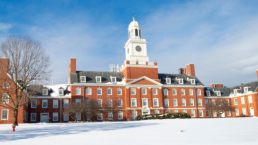US Fulbright student alumni, Henry Henson, just had an article published in Science of the Total Environment. The article is the conclusion of his time spent as a Fulbright student in Denmark and Greenland.
Henry Henson was awarded the Combined Denmark Semester and Arctic Semester in Greenland Grant by Fulbright Denmark to study the implications of climate change on the Arctic in the academic year 2020-2021. During his time as a Fulbrighter, he studied at the the Arctic Research Centre at Aarhus University and later at the Greenland Climate Research Centre (GCRC) in Nuuk, Greenland.
Henry recently had an article published with the findings from his research project in Aarhus and Greenland, and on that occasion we had the chance to talk to him and ask him a few questions about his experience.
“My research project was the first look at the acidification state (a measurement of how acidic the water is — that’s relevant to how marine organisms survive) in Greenland Fjords. By looking at the acidification state in 16 different fjords on East and West coasts of Greenland, we could set the baseline of how acidic the water is surrounding Greenland as well as try to identify the main drivers that make fjord water more or less acidic. Our main highlights from the paper were that:
- Greenland fjords provide an outlook for a future, fresher, Arctic coastal Ocean
- Calcium carbonate corrosive conditions are found surrounding Greenland
- Deep water corrosivity was driven by accumulation of CO2 from remineralization of organic matter
- Surface corrosivity was caused by alkalinity dilution from glacial meltwater
- Greenland Ice Sheet melting will increase already present corrosive conditions
A unique opportunity to explore Aarhus and Greenland
During my time as a Fulbrighter, I loved spending time in both Denmark and Greenland! Aarhus is a lovely town, however, I feel like I have grown even more fond of it since the end of my Fulbright year. To be honest, it was difficult in the beginning making friends in Aarhus as most everything was locked down in the fall of 2020. I was lucky enough to have in-person classes, but no university social events were occurring so it was difficult to meet new people. Thats why my Danish class was the way that I met my first friends. I am also super grateful for my Danish boyfriend. Mads was my strongest social interaction and I ended up “adopting” his friends as well.
Since coming back after the worst of covid restrictions, Aarhus has turned into one of my favorite cities! It really is so much more lively than when I initially moved there. Greenland was also amazing! Even though I ended up there later than expected, my time in Greenland was fantastic. My two months in Nuuk were a blast. It is such a beautiful country, and I had so much fun finally studying what interests me in the field. In addition, I became super close with my Danish roommates I had in Nuuk. Since returning to Aarhus, they have become some of my closest friends during the second year of my Master’s.
Advice for future Fulbright Combined Arctic applicants
If you’re applying for a Fulbright grant, shoot for what you want, and describe how and why studying in Denmark or Greenland is meaningful for your studies or career. It really is the place that makes a difference. Also, take time to think and be honest about what engagement you want to have with the community. Research what clubs or organizations, you could join before you get here so you have a plan of some extracurriculars you could partake in when you move. Danes aren’t always the easiest people to meet. Finally, I would recommend to everyone that moves to Denmark to take Danish lessons. They are not easy at first. However, I have found that since learning Danish I have such a different and better understanding of Danes and Danish culture. I can’t recommend it enough.”
You can read Henry’s article here. For more information about the Combined Denmark Semester and Arctic Semester in Greenland Grant, please read here.
Related
July 1, 2024
Organtransplantation mellem arter – Columbia University
Læs om Sofie á Rogvis udlandsophold ved Columbia University
April 3, 2024
Toxic adfærd i online gaming – Rutgers University
Læs om Louise Anker Nexøs udlandsophold ved Rutgers University
March 15, 2024
Rytme og groove hos ensidigt døve – New York University
Læs om Alberte Baggesgaard Seebergs udlandsophold ved New York University




